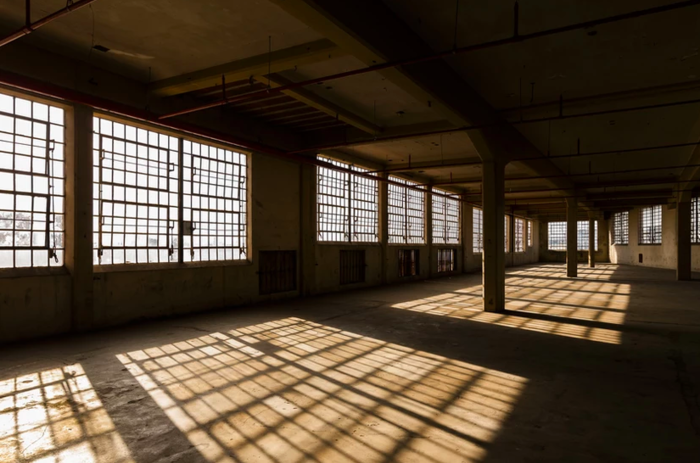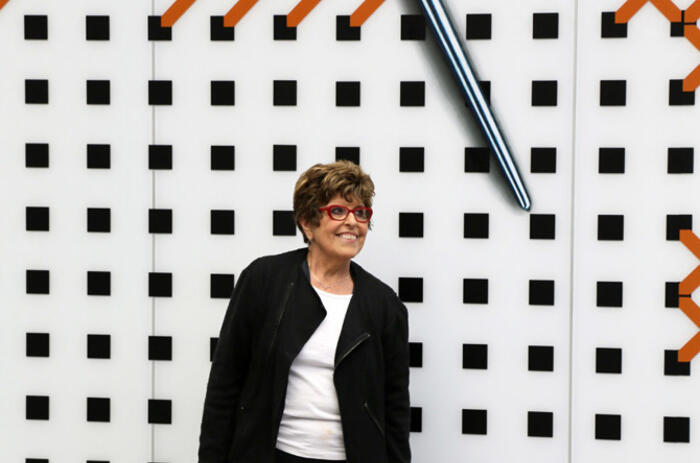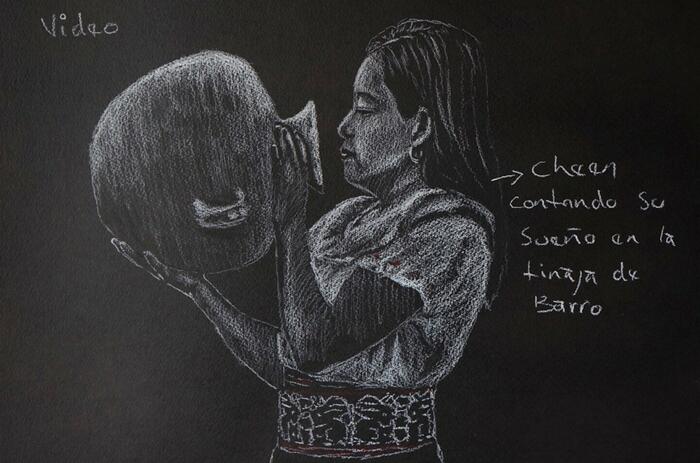"IN THIS BIENNIAL, ART HAS THE ROLE OF BREAKING THE ESTABLISHED SILENCE." INTERVIEW WITH ALEXIA TALA
Alexia Tala is curator of the 22nd Bienal de Arte Paiz that is taking place in Guatemala until June 7. The Biennial of Arte Paiz Guatemala is the most important in the country and the oldest in Latin America.

Last year the Biennial was suspended due to the pandemic. What was it like to face this situation? What changes did you undergo with respect to the project you had put together for 2020?
Yes, we had to run the date for the following year. It was what I would call a negotiation and a new stance towards uncertainty. We lost several sponsors since the budgets had to be reallocated for specific issues in relation to the pandemic, therefore our budget suffered alterations. On the other hand, the eleven museums that would occupy the biennial closed with no reopening date. We were considering those dates for many months, finally having to give up some municipal museums that did not have the conditions to guarantee their use and others that simply already had an agreed schedule for 2021.
I think that two words became very important throughout this process: precariousness and flexibility. We had to learn to mold ourselves to the situation, which changed and continues to change from month to month, and learn to work in simpler and less perfectionist ways ... That is something that costs me a lot but I managed it and despite the fact that no one notices those little ones things that I do notice: it turned out to be a less perfect biennial but much more humanized.
In an interview with ArteInformado you said that it was an opportune situation to “rethink the biennial”. I understand that the biennial this year is absolutely focused on the local, that is, on an educational project adapted to the school and university public of Guatemala. How did this turn happen? What consequences did it have?
Well yeah, in terms of the exhibits themselves, what made the track difficult for us was the travel limitations. As I have said before, these limitations forced us to think in a Glo-cal way (Global and local), that is, we never neglected the importance of creating an international dialogue even though the immediate conditions led us to be local. The educational project was reinforced and we worked more aware of the needs of communicational scope. The consequences or rather the outcome was to have had to carry out a deep reflection process together with my co-curator Gabriel Rodriguez and Cecilia Vilela who organized the symposium to be able to rethink the biennial model and determine which would be the points that we should work with more. force.
I feel that within how to do a biennial there is a good part of creativity and reflection but there is also another more operational one that worked almost on automatic pilot, well it was that automatic pilot that ceased to exist in the face of the pandemic and we have had to pilot manually bypass all that it means to lead down an unknown path, not only for us but for all of us who work in biennials.
How would you describe each axis of the biennial? (Universes of matter, Past. Eternals. Futures and Perverse Geography, cursed geographies).
For me, the importance of defining thematic axes lies in the fact that they are a way of being able to put together a narrative and make it more clearly visible to the public. At the same time, the three axes are not in a disconnected way, but there is dialogue between them. The biennial, more than understanding the current reality, or bringing answers, I would say that it highlights or makes visible many questions that have been silenced but that are part of the context, not only of Guatemala but of Latin America in general.
We did a previous investigation on the context of Guatemala, where researchers, historians, architects, etc. worked and from there it was possible to conclude on three axes that go from matters of ancestry and healing through matter, issues that have to do with the power of the geography, from north to south, and also issues that are repeated in history and that in order to build new futures we must observe and meditate on ancestral knowledge.
How was the symposium built?
The symposium was a very important moment in the biennial, where all the issues addressed led us to observe the approach of the biennial. A place full of questions and with a multiplicity of voices that do not pretend to give answers but do raise even more questions.
It was a space of openness to diversity: of race, of worldviews, of different forms of possible lives to live together. A performative lecture by the Dutch artist Jonas Staal addressed how the power of trillion-dollar companies in the world commands the direction of our lives and leaves us with the question of what would happen and what would be a form of community organization of the 2,500 million people before the possibility of turning Facebook into a company where all users were partners.
And how would you describe the distribution of the various panels?
The panels had very different approaches, such as the contexts of Panama and Guatemala, through a history of exhibitions and through a collection. These countries are mirrors of a large part of the Latin American countries, where the border is a habitable space, it is a territory and it is not a limit. Something that these invisible borders have in common is that they speak to us of political segregation since they have the component of racialization and inequality as a border.
Another panel touched on issues about how the gaze on certain groups is constructed from power and how the West has built a form of identity at its convenience. In the state policies of most countries in the Global South, the fact that indigenous people have been in resistance to various forms of dispossession all their lives is always made invisible. And in the last panel, both presentations told us about the relationship with architecture and plants in both the Mayan and Afro-Atlantic cultures.
What role did architecture play within the general idea?
We saw architecture as an exercise to understand how are the forms of community organization and the importance that is given to listening and about physical and historical healing processes (through the use of plants) at a symbolic level of buildings that became symbols of slavery and power.
You are Chilean and you are curating an artistic event in Guatemala, you were also curator of the Solo sector in SP_arte in São Paulo. I am interested in this concept of Latin American voices that intersect and dialogue, how do you see it?
Well, I lived in England for several years and since my return I always considered a regional job in Latin America. In the last 15 years I have worked in 5 biennials and triennials and this has allowed me to be very up to date in terms of artistic production research, I clearly see the points where art is sometimes homogenized but also clearly where the specificities of the different are territories of our continent that determine the artistic and cultural production of each place.
At the Latin American level, identity is a very present issue in artistic productions, especially when they address ethnic and social diversity and, on the other hand, the shared history of both racial and political violence in the region, the dialogues occur in the various forms of approach , in the diverse interests of the artists and in their languages, which are influenced by their own life experiences in their determined places.
You have developed a research work positioning yourself in the Biennials, what interests you the most in this field?
I see biennials as a great laboratory where you can work beyond the limits of art, you can work transdisciplinary, and create unconventional formats. I am interested when exhibitions are the result of something procedural where there is knowledge, relationships and interrelations with other fields and not only that of art, but what happens during the previous two years for me is as integral part of the event as they are. the exhibits. I am interested in the idea of immersing myself in a new context to deliver a project that is not alien to their communities.
As in any project, certain guidelines are drawn up and one tries not to lose sight of them, but in a biennial there are many licenses to take detours to make changes and to make adaptations to situations, works or artists that appear when one does not expect it. In short, my way of working and what interests me about biennials is to be in a constant attempt that the curatorial framework never catches me.
How do you see the Bienal de Paiz, positioned within the Biennials in Central and South America?
The Bienal de Arte Paiz-Guatemala is a very old biennial but only in its last 6 editions is it opening to become an international biennial. This change has been gradual and has grown with each edition. Unlike the Polygraphic Triennial of San Juan, Latin America and the Caribbean in which I worked a few years ago, that triennial at a certain moment made a resounding change of direction and positioning led by Mari Carmen Ramírez. I feel that the Paiz Biennial has the potential to establish itself as a benchmark biennial within other biennials in the region.
In the presentation of the biennial (which you could not attend but accompanied through a video) it was said that one of the most important axes was to address human rights violence in Guatemala and you mentioned the importance and need for freedom of cultural expression. However, in Latin America there is still a high degree of human rights violations (including censorship, poverty and immigration). How did you set out to deal with this sensitive issue? What role do you think art plays in these situations?
Certainly Latin America is in a historical constant of violations of human rights and all that that entails. We proposed to approach it in the most respectful way possible, making the biennial a platform for multiple voices to express themselves, many of them were already doing it from very shy places, somehow the dialogues led to a certain loss of fear and to feel that this breaking the silence was done collectively. In this specific biennial, art has the role of breaking the established silence. The policy of silence in countries like Guatemala is difficult to break, but it is very necessary.
And speaking of the role of art for which you also ask me, about what you heard in that opening speech, I was referring to exactly that, I was referring to the opening of the Paiz Foundation itself to give the curatorship the freedom to address issues as complicated as these. I am truly admired and grateful that we were able to reach port with this biennial taking care of these issues since, in addition to the general public that has received the samples very well, it is also the elite who at the same time try to raise awareness. That is the role of art.









